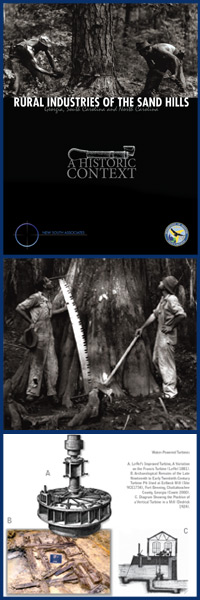 The Sand Hills is a unique geographic region extending through Georgia and South Carolina, and into North Carolina. The region reflects an ancient Atlantic Ocean shoreline that overlaps the fall line in these states. Owing to its position at the falls of major rivers, which created opportunities for water power development, combined with extensive mineral, forest, and agricultural resources that provided raw materials for certain products, the Sand Hills became an important industrial sector. Thousands of archaeological sites reflecting rural industrial operations are within six United States military installations based in the Sand Hills: Fort Benning, Robins Air Force Base, and Fort Gordon, Georgia; Fort Jackson and Shaw Air Force Base, South Carolina; and Fort Bragg, North Carolina. The requirement that each installation inventory and evaluate archaeological resources in its possession inspired the creation of a document that offers assistance in dealing with these particular types of sites. Under a grant from the Legacy Resource Management Program of the Department of Defense, and on behalf of Fort Gordon and the U.S. Army Corps of Engineers, New South Associates prepared Rural Industries of the Sand Hills, Georgia, South Carolina, and North Carolina: A Historic Context.
The Sand Hills is a unique geographic region extending through Georgia and South Carolina, and into North Carolina. The region reflects an ancient Atlantic Ocean shoreline that overlaps the fall line in these states. Owing to its position at the falls of major rivers, which created opportunities for water power development, combined with extensive mineral, forest, and agricultural resources that provided raw materials for certain products, the Sand Hills became an important industrial sector. Thousands of archaeological sites reflecting rural industrial operations are within six United States military installations based in the Sand Hills: Fort Benning, Robins Air Force Base, and Fort Gordon, Georgia; Fort Jackson and Shaw Air Force Base, South Carolina; and Fort Bragg, North Carolina. The requirement that each installation inventory and evaluate archaeological resources in its possession inspired the creation of a document that offers assistance in dealing with these particular types of sites. Under a grant from the Legacy Resource Management Program of the Department of Defense, and on behalf of Fort Gordon and the U.S. Army Corps of Engineers, New South Associates prepared Rural Industries of the Sand Hills, Georgia, South Carolina, and North Carolina: A Historic Context.
“Rural industries” refers to the small-scale activities that took place in communities where the dominant economic pursuits revolved around agriculture or natural product extraction, and where industry supported these activities and processed their output. Specific industries found at the installations or in nearby parts of the Sand Hills include saw- and grist-milling; forest products, particularly lumber and naval stores; clay working, such as ceramics and brick making; black smithing; cotton ginning and cottonseed oil; and liquor distilling (both legal and illegal). Additionally, the Sand Hills was, and remains, a major producer of kaolin for industrial applications. These industries reflect a range of distinct activities, processes, and procedures, as well as varying levels of capital investment, labor organization, and impacts to the social and natural environments. Studying them over time and across a broad region such as the Sand Hills provides an opportunity to examine aspects of historical and economic development, while the large holdings of military installations makes them important participants in the conservation of archaeological data.
The goal of this project was to provide information necessary to evaluate the archaeological research value of sites reflecting rural industries. The historic context was developed from the existing archaeological and historical inventories and evaluation studies of sites associated with the six Sand Hills military installations. The context identifies the rural industry property types associated with the Sand Hills region, reviews the attributes associated with each, considers each property type found at the various DOD installations and reviews the significant studies of each, discusses their locations and distributions, and considers the research potential of each class of properties. The context concludes with specific steps necessary for evaluating the National Register of Historic Places eligibility of archaeological sites related to rural industries. An important outcome of these historic preservation activities is that rural industrial sites have interpretive value for connecting the archaeological resources of an installation to the local community and for providing educational opportunities to the forces training and operating at them.
